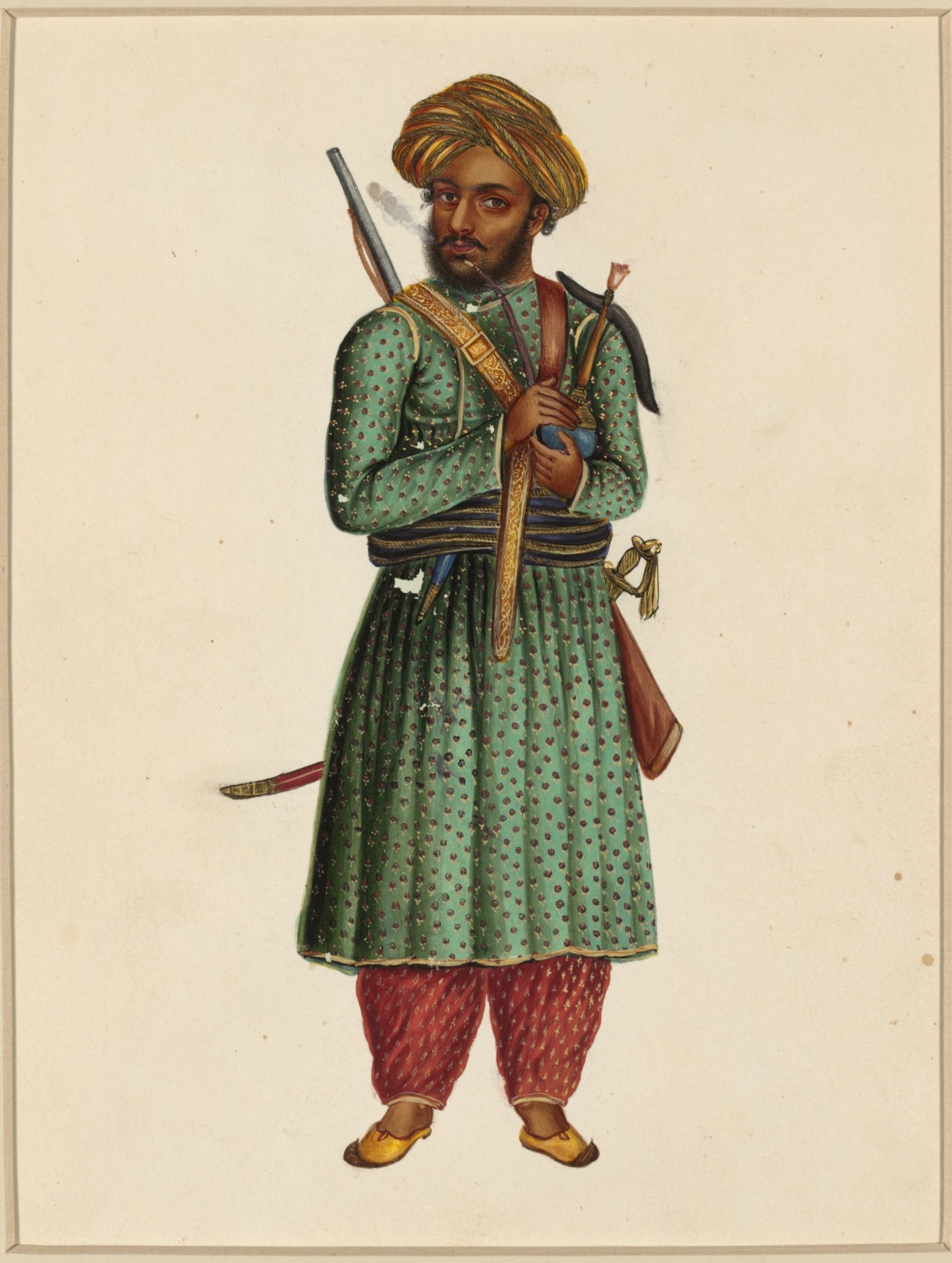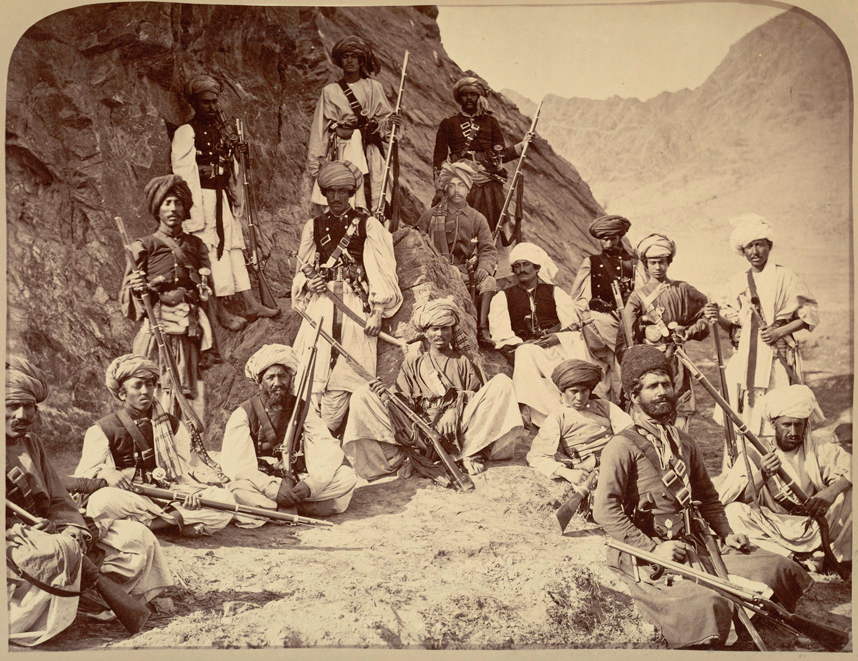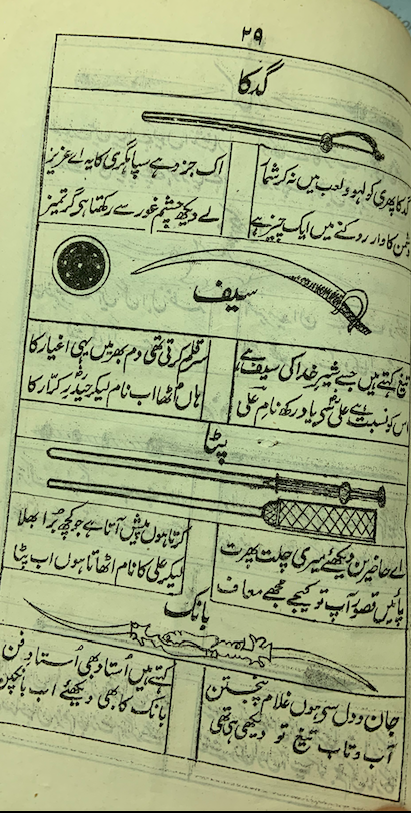The following article is written by Amanda Lanzillo. She holds a PhD in South Asian history at Indiana University-Bloomington. Starting in Fall 2020, she will be a postdoctoral fellow with the Princeton University Society of Fellows. Her research focused on the intersections between artisan laboring cultures and Muslim identities in colonial-era India.
Beginning in the mid nineteenth century, the British army in India selected local recruits based on racialized assumptions that some groups of Indians were inherently “martial.” After its formation under the British East India Company in the seventeenth century, the British army in India relied heavily on Indian troops. However, following the Uprising of 1857, when many Indian recruits rebelled against British officers, British military administrators began to borrow from the work of colonial ethnographers to identify new Indian recruits. These ethnographers categorized Indians within rigid caste and ethnic boundaries and often portrayed cultural practices as biologically predetermined, despite forms of flexibility and the shifting nature of these practices on the ground. Ethnographers argued that climate, diet, and forms of community organization all contributed to a community’s “martial” nature, although in practice, British military administrators also chose martial races based on which groups they believed were unlikely to rebel. Ultimately, colonial proponents of “martial race theory” claimed that groups like “Sikhs, Gurkhas, Dogras, Rajputs, and Pathans” were intrinsically suited to military work.

Martial race theory quickly exceeded the bounds of military recruitment. It has influenced popular South Asian narratives of ethnicity, masculinity, honor, and regional identity from the nineteenth century through the present day. This article analyzes the application of martial race theory to labor external to the military, and particularly its influence on artisan trades. It focuses on the working lives of Pathans, a term used in India to describe the diverse descendents of Pashto-speaking groups who had migrated from Indo-Afghan frontier regions. In categorizing Pathans as a martial race, authorities created new barriers to Pathan laborers’ and artisans’ access to non-military trades. Pathan traditions of artisanship were erased by a racial ideology that portrayed them as skilled only in “martial” trades like weaponsmithing.
New social limitations on Pathan artisanship arose roughly contemporaneously–in the late nineteenth century–with new colonial regulations on weaponsmithing. Colonial regulations made it more difficult for Pathans to sustain livelihoods through weaponsmithing, forcing many to engage with the colonial military through employment in armaments factories. The categorization of Pathans as a martial race limited the previously diverse sphere of Pathan artisanship to weaponsmithing. While colonial “martial race theory” claimed only to describe a reality, when it became part of British colonial governance, racist theory was turned into reality. Because they considered Pathans as unsuited to forms of artisanship besides weaponsmithing, British authorities converted even those Pathans who did not serve in the military into “martial” workers. Today, concepts of “martial races” continue to shape popular stereotypes about a variety of ethnicities in South Asia. But the history and erasure of Pathan artisanship reveals that these stereotypes are in part rooted in the legacies of British colonial race theory and policy.

British definitions of “race” and “martial character:” The case of Pathans
Associations between Pathans and military prowess long preceded colonial rule, but prior to the nineteenth century they were not mapped onto ideas of an immutable Pathan “race.” Rather, because many Pathans migrated into India as members of military forces between the fifteenth and eighteenth centuries, they evolved norms of masculinity, codes of honor, and understandings of the past rooted in military service. Pre-colonial Pathan ethnic and military identities retained a degree of flexibility, and did not preclude ability in non-military trades.
However, based on colonial ethnographies that portrayed Pathans as aggressive, quick to anger, dependent on brute force, nineteenth-century British administrators assumed that Pathan military ability was inborn and incompatible with most artisanal skills. This exclusive emphasis on what Europeans saw as an inherent Pathan martial nature also erased Pathan women. British ethnographers rendered Pathan women invisible in their racialized narratives, except when using them to characterize Pathan men as bound by strict martial codes of “honor.” Ultimately, for laboring Pathans, these narratives meant they were legible in the colonial archive only when they created items, like guns and swords, that conformed to British understandings of “martial” work.

From artisanship to “martial” labor and weaponsmithing

Prior to the consolidation and application of colonial martial race theory, Indian Pathans were recognized for their skill in weaponsmithing, but they also developed artisan traditions in other trades. The North Indian region of Rohilkhand was named for the Rohilla community of Pathans, who settled in the area and ruled it until 1774, and its cities and towns were home to large communities of both elite and working class Pathans. In eighteenth- and early nineteenth-century Rohilkhand, Pathan artisans earned renown for work ranging from decorative elephant prods to lacquered wood furniture, as well as pattern-work, masonry, and decorative carving for regional architecture. Moreover, before the mid nineteenth century, many Rohilla Pathan metalsmiths who made guns or swords did not specialize exclusively in weaponsmithing. Metalsmiths with the skills necessary to make weapons also secured commissions to create decorated dishware, boxes, and metal engravings.
Muḥammad Bakhsh, born around 1845, was a Rohilla Pathan artisan who lived through the consolidation and popularization of colonial racial stereotypes about Pathans. His work reflects the ways in which colonial notions of race were mapped onto the profession of metalsmithing, even as Pathan metalsmiths continued to engage in practices beyond weaponsmithing. Muḥammad Bakhsh trained in gold- and silver-work, as well as blacksmithing. He was commissioned by the Indian princes of regional states to make betel-nut cutters (sarūtā) and boxes (pāndān), both used for paan, a preparation of betel leaf and nut often chewed as a freshener. Despite his diverse skills, Muḥammad Bakhsh was lauded in later Indian-authored regional histories only as a weaponsmith, with several appending “gunmaker” (bandūqsāz) to his name. In both Indian and British-authored sources, artisans like Muḥammad Bakhsh attracted attention for their ability to fashion firearms. The varied talents of Pathan metalsmiths were erased in favor of a racialized colonial narrative that claimed that Pathans possessed an inherent affinity for weapons.

New legal and economic regimes of weaponsmithing
New laws regulating the production and sale of weapons in British India complicated the efforts of Pathan artisans to secure work under a colonial regime that depicted them as suited only to weaponsmithing. For instance, the 1878 Indian Arms Act created a strict licensing system for the Indian arms manufacturers and placed limits on ownership. Moreover, even before 1878, it was challenging for Indians to make a living in gunsmithing due to the importation and popularity of guns from Britain, especially Birmingham. By the early nineteenth-century, British imperial policies forced the Indian market to be open to British imports, but the British market was subject to protectionist regulations. In the case of gunsmithing, this imbalance in trade relations provided an opening for Birmingham smiths to the detriment of Indian producers. For Pathan artisans, it meant that even as racialized colonial narratives pushed them toward weaponsmithing, they struggled to sustain livelihoods as weaponsmiths.

Pathan artisan responses and adaptations

By the early twentieth century, many Pathan artisans found that they could not legally sustain livelihoods as weaponsmiths. At the same time, the increased acceptance of martial race theory within Indian social discourse meant that they were popularly perceived as unskilled in alternative forms of artisanship. One way that some Pathan workers responded to this challenge was by asserting that other industries–like scissor-making–were aligned with weaponsmithing, and therefore relevant to colonial assumptions about their inherent skills.
Muḥammad Ṣabīḥuldīn Shāhjahānpūrī, author of a 1931 history of the town of Shahjahanpur in Rohilkhand, articulated what seems to have been a popularly held view among Pathans of the region. Suggesting that making items like scissors and sarūtās (betel-nut cutters), two popular industries in Shahjahanpur, relied on the same skills needed for weaponsmithing, he explained that many Pathan laboring families had shifted to these trades. However, Muḥammad Ṣabīḥuldīn also argued that scissors and sarūtās could not sustain the entirety of the town’s large working class Pathan community, lamenting that Pathan workers were increasingly impoverished. His depiction of Pathan artisans and laborers suggests that while some succeeded in transitioning to trades perceived as aligned with weapons, others struggled to find work within the late colonial social and legal context.
Some Pathan artisans also migrated to quasi-autonomous “princely states” in search of work. These states were under British suzerainty but retained some autonomy in internal affairs, and many did not adopt British laws about the manufacture of weapons. For Pathan artisans who relied on weaponsmithing for work, they provided a potential space for employment. In most cases, however, it was only the most regionally renowned Pathan artisans who secured work in these states. Small states like Rampur, a Pathan-led state within Rohilkhand, became known across North India for the quality of its weapons, in part due its employment of artisans from other towns in Rohilkhand. However, the limited size and economic influence of states like Rampur meant they were never able to provide sufficient opportunities to sustain Pathan artisans across the entire region.

The self-fulfillment of martial race theory
The fact that neither trades perceived as aligned with weaponsmithing nor princely state employment could provide work for the majority of the Pathan laboring community pushed many to seek work in colonial armaments factories. By the early twentieth century, British Indian defense forces developed their own weapons and artillery in “ordnance factories.” Pathan workers from Rohilkhand migrated across India in search of these new factory jobs. Indeed, colonial reports on factories in regions as diverse as Central India and Bengal note that members of Muslim groups classed as “martial,” including Pathans, formed the majority of laborers at ordnance factories. Munitions factory employment was often the highest-paying option for Pathan artisans, many of whom could no longer legally secure independent work as weaponsmiths but faced social pressures that blocked their access to other trades. While armament factory work meant a steady income for Pathan artisans, it also integrated them even more fully into the colonial narrative of Pathan artisanship as rooted in a “racial” martial nature.

Martial race theory was ultimately self-fulfilling, including for working class members of so-called “martial races” who attempted to build livelihoods outside of the military. British administrators racialized Indian Pathans as an inherently martial people, erasing histories of artisanship outside of weaponsmithing. Both European and Indian employers increasingly accepted and enforced martial race narratives in the late nineteenth century. Pathan artisans therefore struggled to secure work outside of weaponsmithing in a period when colonial laws restricted their access to that trade. Many ultimately accepted employment in British armaments factories, forcing them to further engage with the colonial state’s racialized military practices.
Scholars have long argued that South Asian ethnic stereotypes about martial ability, which continue to influence the demographics of the region’s military forces, are rooted in nineteenth-century colonial constructions of race. The prominence of Punjabis in both the Indian and Pakistani armies, the continued recruitment of ethnic Nepali Gurkhas to the British army, and the use of caste in some Indian army recruitment all reflect colonial martial race theory. But martial race theory also had far-reaching consequences beyond military recruitment. The idea that Pathan artisans laborers were inherently skilled in weaponsmithing was likewise based in colonial martial race theory and contributed to the erasure of the histories of other forms of Pathan artisanship.
The case of Pathan artisans shows that martial race theory limited forms of social and economic mobility among the working classes of so-called “martial groups,” often forcing them to engage with the colonial state’s military system in order to sustain livelihoods. British colonial authorities and ethnographies, while claiming merely to describe the world they encountered upon colonizing India, were in fact responsible for shaping and creating that world. Today, many of these stereotypes persist in South Asia and are imagined to be timeless; but as the erasure of Pathan artisans shows, these stereotypes reflect the racism of the colonial legacy.
Further Reading:
Muḥammad Ṣabīḥuldīn Shāhjahānpūrī. Tārīkh-e Shāhjahānpūr (History of Shahjahanpur) Lucknow: Nami Press, 1931.
Ibn Ḥassan Khūrshīd. Taẕkira-yi hunarmandān-i Rāmpūr (History of the Artisans of Rampur) Rampur: Raza Library Press, 2001.
Makhzan-i ṣanʿat o ḥirfat Bakhshī (The Bakhshi Repository of Industries and Trades) Kanpur: Bakhshī Press, 1900.
L.F Begbie. A Monograph on the Iron and Steel Industry in the Central Provinces. Nagpur: Secretariat Press, 1908.
J.L Maffey. A monograph on wood carving in the United Provinces of Agra and Oudh. Allahabad: Government Press, 1903.










4 comments
Good work! Very interesting article, but what is the name of the “guest contributor” who has written this article? How can one cite the article without the author’s name, unless the “guest contributor” is the “Ajam Media Collective” itself? And if that is the case why state that the article is by a “guest contributor”? I will appreciate a response.
The author’s name & bio are written right at the top of the article.
This was a fascinating read. The perspective was extremely interesting,I had not thought of the martial race theory in such terms. Would it be possible to get in touch with the author? I have done an M.Phil on various professions in 16th and 17th century India and would love to get the author’s views on related topics.
This was an amazing read. Full disclosure, I may be biased as I’m a Rohillah whose family came from Rohilkhand. Thanks for the research and write up Amanda!